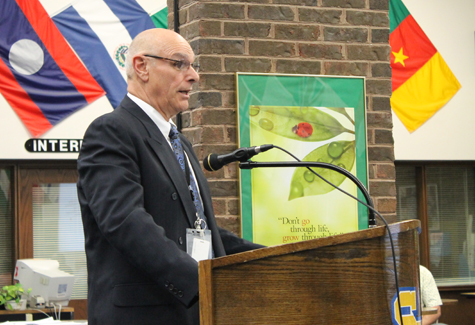Special education class size changes draw concerns at SWR meeting

A new Shoreham-Wading River district policy on special education classroom sizes drew concern at Tuesday night’s school board meeting.
The chief concern was that, while the policy was made with good intentions now, future school boards could abuse it to cut costs.
The policy increases the maximum ratio of students to teachers and aides from 12:1:1 to 15:1:1 for special “learning center” classes in the district, explained the district’s interim director of student services, Charles Althoff.
The new policy was proposed due to a change in state waiver responses, Mr. Althoff said.
The district had previously worked under the 12:1:1 ratio, and would occasionally have students move into the district during the school year. Rather than break up a 12-student class and disrupt classes, school officials would file a waiver request to the state to get a variance.
“Once the kids get [into their classes] they should stay there,” Mr. Althoff said.
But recently, the state has cut back on employees, and now waiver requests take too long to be completed, he said. The new policy allows the flexibility the waivers would have provided, and calls for an understanding that the district would not start classes of over 12 students to prevent consolidation for cost-cutting measures.
But school board trustee Richard Pluschau, who has a special needs child, said he was concerned that with future budget cuts looming because of the state-mandated 2 percent tax levy cap, future administrators would abuse the policy to save money.
Instead of hiring two teachers to teach two classes of seven, Mr. Pluschau said, future school boards may combine the classes into one. He added that on average, the cost of educating a special needs student is higher than the average student, and may become a target when budget cuts are necessary.
“I can’t criticize you for this because you have all the positive intentions right now,” Mr. Pluschau said to Mr. Althoff, “You’re doing it to help the kids, but I just worry about a precedent for the future.”
A presentation on the school budget Tuesday night showed that special education costs for 2012-13 would rise by more than 20 percent from this school year budget to $3,012,641 in total. Of the $500,000 increase, more than $300,000 is from a change in state policy in December made retroactively to this school year which forces districts to pay more than 18 percent more in tuition rates for special needs students who need educating elsewhere.
The remaining increase is due to unanticipated enrollment in special education and other related services.
Resident Alonna Rubin, who also serves as the co-president of the Shorham-Wading River Special Education Parent Teacher Association, said that personally, she agreed with administrators that the policy would help children now, but shared the same concerns Mr. Pluschau had about future board actions.
Ms. Rubin asked the board if there was a way to guarantee the school would not open classes at the new, higher maximum as a cost-saving measure in the future, but Dr. Cohen said there was no way to enforce future decisions made by boards that don’t exist yet.
However, Mr. Althoff said that any future administrator would be foolish to max out classes at the beginning of the school year, because then the district would be left scrambling to break up classes if more students move into the district during the school year.
“To open up at 12 [students] would be an administrative mistake for any administrator to make,” he said.
The school board eventually reached a consensus to approve the policy.
Superintendent Steven Cohen’s proposed $62.4 million budget 2012-13 school budget, which calls for a 3.98 percent spending increase from this year’s budget, would keep the district under the state-mandated 2-percent tax levy cap, which limits the total amount of money the district can collect from taxpayers.
Rather than deal with cutbacks to special needs education or any other programs to remain under the cap, the district is pulling about $3.75 million from its reserve funds to make up for lost tax revenue — about double what was taken from the fund last year. School officials have said there is more than $16 million available to the school between the various reserve funds, some of which must be spent in the coming years due to state regulations.
The reserve funds will be tapped since all the money in the fund balance — the surplus left unspent from the this years’ budget, such as reduced heating costs over the warm winter — is depleted, officials said.








